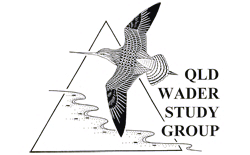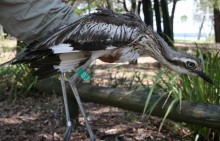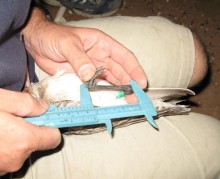Bands are provided in a range of different sizes for different species, but every band, irrespective of size carries a unique code, allowing a bird to be individually identified and has an address on it, so that the banding scheme that issued the band can be contacted and details of the origin and destination of the bird provided to both the bander and the finder of the bird.
The bands are open rings and specials pliers are used to close them around the leg of the bird. The bands do not close tightly onto the leg, cause no harm and are extremely light in relation to the weight of the bird.
The leg flag is made of thin plastic and engraved with a unique 2 or 3 alphanumeric code. These are put on the upper leg and the two sides of the flag portion glued ensuring that the flag cannot fall off.
The real value of the flag is that it can be read with a telescope or even binoculars, without having to recatch the bird. This allows us to generate many many sightings of the same individuals and build up detailed information of roosting locations, feeding locations and migration stopover sites at an individual level. The number of times that birds are recorded in the same locations gives us a good indication of the importance of those locations to those individuals.
Banding is only part of the purpose of catching a shorebird however. We also measure and weigh every bird to establish how large the bird is and to establish what condition the bird is in. We take a whole range of measurements.
- Wing Length (in Millimetres)
- Total Head Length (in Millimetres)
- Bill Length (in Millimetres)
- Tarsus Length (in Millimetres)
- Weight (in Grammes)
In many cases the measurements also allow us to identify the sex of the birds we catch and the next page in the series explains how to tell the age and sex of some of the commonly caught species. The banding and measuring process only takes a few minutes after which the bird is released unharmed and we can start to monitor it.


